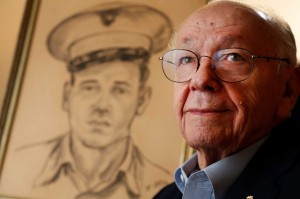
Iwo Jima veteran to share his story on 70th anniversary
Bill Sherrill watched from the deck of an attack transport off the coast of Iwo Jima as artillery shells thudded into the small, porkchop-shaped island.
For hours, explosions tore across the landscape as salvo after salvo smashed into its beaches and forests in an initial effort to clear out 20,000 Japanese defenders.
The island, with its beaches of gritty volcanic ash, a few sulfur pits, and three airfields, lay 600 miles south of the Japanese mainland and was close enough to put American forces at Japan’s doorstep.
Seventy years after the ferocious battle, the impressions of the conflict remain with Sherrill – from the Purple Heart and photos he keeps at his house to the gold USMC pin he wears in his lapel.
It was hard to believe anything was still alive after the bombardment, he remembers thinking. But when thousands of Marines waded ashore, Japanese forces hidden in bunkers counterattacked.
“Very quickly it became obvious that it was going to be a tough campaign,” said Sherrill, now 88.
He will be sharing some of those memories at a commemoration of the battle’s 70th anniversary Thursday evening in the East End, one of dozens of ceremonies around the country honoring the veterans who served in that battle.
It came four years after Japanese forces launched the surprise attack on Pearl Harbor that galvanized America into full participation in World War II.
Just weeks after the Hawaiian attack, Sherrill, then 15, wandered into a Marine recruiting office in Houston and enlisted.
“They were willing to take any boy who could use a rifle,” he said, recalling the threat of a possible attack on the U.S. mainland. His enlistment papers show him then – lean, unsmiling, with a crew cut, and a false birth date in 1924.
“I’m from Texas. I exaggerated,” joked Sherrill, who lives in west Houston, just a few miles from where he grew up.
Marine Lt. Col. Eric Gillard, executive officer with the Naval ROTC in Houston, plans to attend Sherrill’s talk with some of his midshipmen.
“All too often, in the military, we tend not to talk about our experiences. It’s too painful, or [we] think people won’t be interested, or won’t understand,” Gillard said. “This is a fantastic opportunity to talk to someone who was there – a living historian, if you will.”
Capturing Iwo Jima “meant you could have a real territorial stronghold close to the Japanese mainland, hence why they had it so fortified and why the fight was so bloody,” said Douglas Brinkley, a professor of history at Rice University whose specialty is World War II.
A defeat would have been a “huge setback” in the U.S. war effort because the island was a crucial part of America’s “island-hopping” strategy in the Pacific theater, Brinkley said.
Iconic photography
The conflict there was made all the more famous by an iconic photograph of five Marines and a Navy Corpsman raising the Stars and Stripes on the fourth day of the engagement on the summit of Mount Suribachi, an extinct, 550-foot volcano at the island’s southwestern tip.
“Many thought it was over [when the flag was raised], but they hadn’t gotten to the really heavy fighting at that point,” said Sherrill, who went ashore on the island with K Company, in the Third Marines, Ninth Battalion, a week after the initial assault.
They were there to reinforce two Marine divisions that had taken heavy losses in earlier fighting, and were among more than 70,000 U.S. Marines, U.S. Navy corpsmen and U.S. Army Air Forces airmen who participated in the five-week assault. The battle eventually claimed more than 6,000 American lives and wounded 19,000. Most of the Japanese on the island died in the conflict.
Four days after Sherrill and his comrades landed on Iwo Jima’s beaches, mortar barrages wiped out two-thirds of his 245-man company.
The survivors spent days dodging grenade attacks and sniper fire. A week after landing, Sherrill, a corporal, was walking near an unfinished airfield, waving his men along when he locked eyes with a Japanese rifleman.
“The minute I saw him, he fired,” said Sherrill.
There was a sting, and his arm “just dropped.”
A rifleman who was with him shot the Japanese soldier before he had a chance to finish off Sherrill or kill other Americans.
“He shot the wrong man,” Sherrill said, still thankful to this day that the bullet hit him instead of his comrade.
A medic patched him up, but the wound would mark the end of Sherrill’s combat career.
Days later, after he’d been shipped back to Guam, a doctor discovered the wound had caused permanent nerve damage and sent him back to Hawaii. From there, he was shipped to a hospital in Oakland, where he finished recuperating.
While there, Sherrill, who had never finished 8th grade, earned his GED. His discharge, in 1946, left him reeling. His four-year adventure had taken a poor city boy from Houston halfway around the world. But he avoided the post traumatic stress that plagued many other veterans, which he attributes to an unmistakable belief that the people he fought were trying to kill him.
“I killed my share, but I never murdered anybody,” Sherrill said. “I never killed anybody who wasn’t actively trying to kill me.”
If Marines call, he answers
Once he returned to Houston, a series of “minor miracles,” as he describes them, touched off his academic career, which started at the University of Houston and then led to a master’s degree from Harvard Business School.
Soon Sherrill was wrangling business deals. His career took him from chief administrative officer of the city of Houston, to serving as the president of a local bank, to businesses around the country, to his own financial consulting firm, to the corridors of power in Washington and a stint on the Federal Reserve’s Board of Governors.
In 1990, he returned to Houston, and became a professor at UH’s Bauer College of Business Administration, where he founded the Center for Entrepreneurship and Innovation. Sherrill married and divorced twice, raising three daughters. He has four grandchildren, and two great granddaughters.
Now aged, his hand still bothers him at times. His hearing is going, but he keeps busy, still working at UH, and occasionally sharing his story, especially with other veterans and veterans’ groups.
“When the Marine Corps calls, I say ‘yes!’ ” he said.
David Cantu, a Marine who asked him to speak at Thursday’s event, hopes Sherrill’s story inspires other returning vets.
“He overcame being uneducated. After being wounded, he educated himself, got a degree in finance … he went back and did something with his life,” Cantu said. “For those coming back from Iraq and Afghanistan, wondering what they need to do with their lives, all they need to do is look at Mr. Sherrill and see how many times he overcame things.”





Leave a Reply